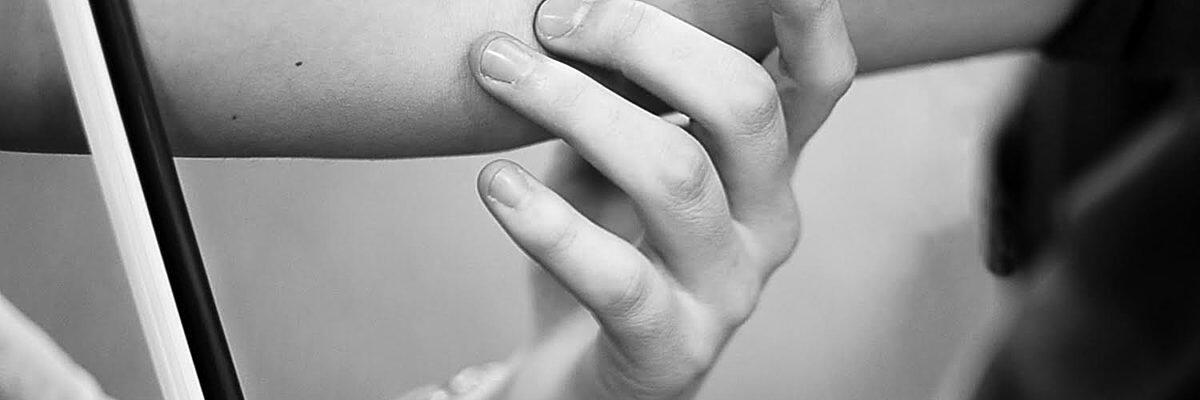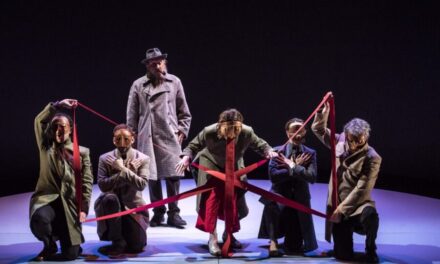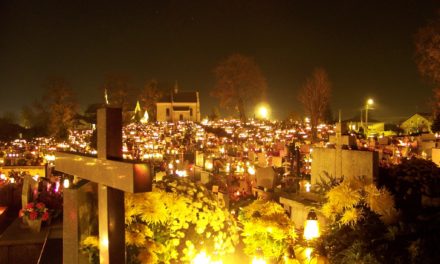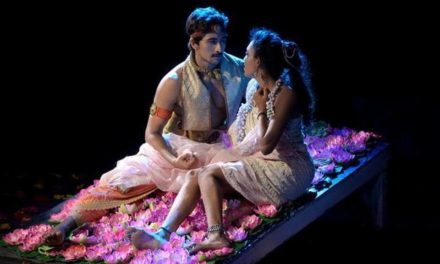New Nexus Formed
After several projects which look into ways to expand performing art’s notion of ‘spectatorship’ beyond the predominance of the visual, Vera Tussing’s new project at the Kaaitheater, though still relying on it, goes beyond just the touch of the hand.
The audience takes place on the stage of the Kaaitheater. The glaring light, coming from where the audience would normally be positioned, reveals two rectangles on the stage floor; one straight, the other diagonally marked. Three levels of chairs line the sides and the back of the stage, forming its frame, leaving open the side of the auditorium. Looking out to the ghostly spectators, the audience, now in the space of the performer, also sees at the far end of the stage two video screens hanging down. They show moving images of two or more hands touching one another sensuously, giving a sense of fluidity.
The first dancer comes into one of the rectangles and mimes that kinetic fluidity, paradoxically, with an immovable foothold. Slowly one by one, the three others—each reacting to and improvising on the ‘figure’ that the preceding dancer has created—gradually join in until a bodily ‘quartet’ is formed. Then, the sound and the sight of the quartet band Quatuor MP4 emerge from the opposite end of the black box: from what would normally be the second floor of the audience’s seating area.
Here, placing a group of four dancers alongside a string quartet, Tussing’s choreography—expanded to go beyond dance on stage—is referencing a deep structure shared between two specific types of social organization which similarly involves the participation of four human bodies. That is, in dance: the ‘pas de quatre’ of classical ballet, and in music: the string quartet.
Particularly when we think of Tussing’s repositioning of the audience onto the stage as a choreography, this consideration of social organization is also extended to that of human society at large. A performance marketed as a touchy ensemble, therefore, turns out to demand you into thinking: how do we organize ourselves as a collective? How do individuals become a group? What are the rules underlying these congregations?
In the article ‘On Tactile Quartet(s)’ where Tussing and JS Rafaeli share their thoughts on the show as an introduction, available before one enters the black box, the answer to this set of questions seems to rest on the words ‘hierarchy’ and ‘authority’. Among other examples, Tussing’s and Rafaeli’s reference to Georg Friedrich Haas’s remark is the most telling: ‘there are very few moments in society when one person can tell another exactly how to move their fingers—and how to breathe’.
And that is precisely what the members of the Quatuor MP4 do, together with the dancers in the second half of the performance, with the participating audience in their collaboration to produce the much-awaited tactile quartet. The string quartet members move their bows and fingers on the participating audience’s arms. The sound ‘produced’ is, interestingly, delegated from the recordings of what the group has played during the previous moments of the show before it takes over. (This resonates well with the recorded film of hand movements which the dancers use to accompany their dance preceding the tactile quartet.) Markedly noteworthy are the literal instructions each musician gives to the participating audience who literally lend their hands as instruments. We are told how to behave while they play us. In my case, luckily enough to be picked by Tussing herself to sit as the cello, the instrument I most identify with, the cellist told me to read the score from one line to another while she plucks my arm doing pizzicatos with occasional bowing. As a participating audience, it dawns on me how, not only playing but also listening and enjoying a particular type of music is, in fact, a branch of social engineering. Here, through her human choreography, Tussing has taken the musical turn in the field of performing art yet to another level—a tactile assemblage revealing a form of political organization.
What is also interesting is Tussing’s choice not to give equal footings between dance choreography and the tactile quartet. That is, while the tactile quartet’s participating audience is left to remain in a situation where they are still subject to the authority of the musician who is playing them, the four dancers—despite starting off with a choreography of subjection (being controlled), being framed in the rectangles and having their feet ‘glued’—eventually resolve into breaking free from those shackles.
Tactile Quartet(s) sees Tussing’s well-thought-out expansion of her long-standing commitment to exploring the audience’s sensorial potentialities to engage with the wider politics of assemblage. This is where her preoccupation with tactility has become an enabling factor for us to think about the power structures underlying any human organization, which in this case encompasses that in dance, music, theatre spectatorship and society as a whole. This newly formed nexus between tactility and activation of political awareness can and will go a long way as it promises a myriad of creative variances in varied forms. Coupling with it is the artist’s signal to rethink the relationship between the spectator and the performer; between spectacle and participation. The tactile quartet does indeed ask what it means for the spectators to become part of the performance and be looked at. All these elements come together to contribute to the artist’s enduring effort to trouble ‘spectatorship’ as we know it.
This article was originally posted at Etcetera and has been reposted with permission. To read the original article, click here.
This post was written by the author in their personal capacity.The opinions expressed in this article are the author’s own and do not reflect the view of The Theatre Times, their staff or collaborators.
This post was written by Rathsaran Sireekan.
The views expressed here belong to the author and do not necessarily reflect our views and opinions.


















